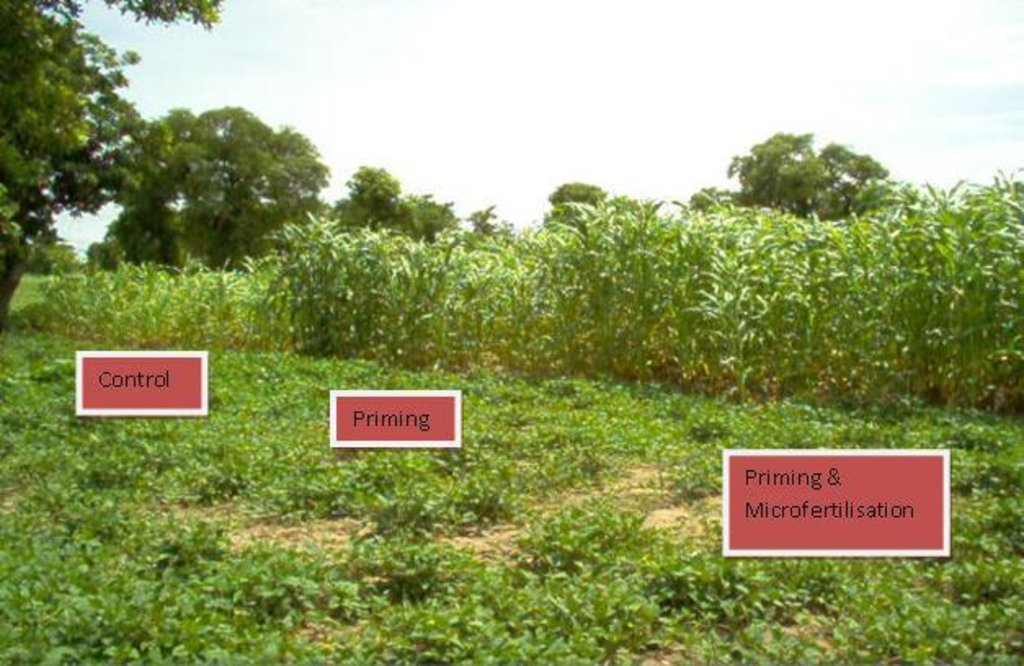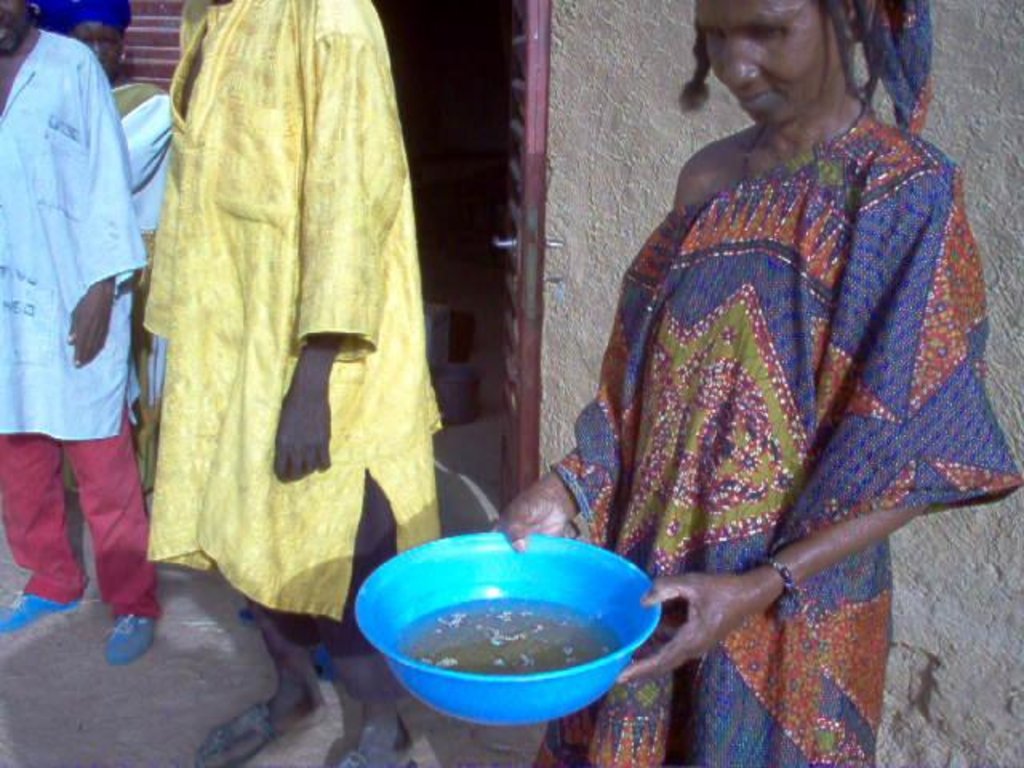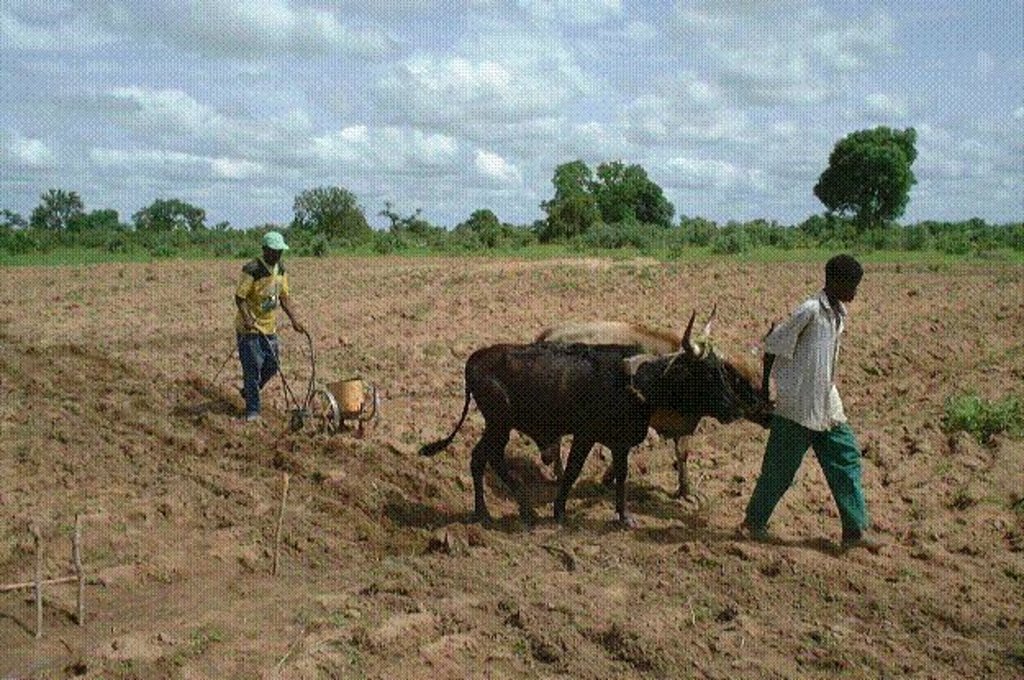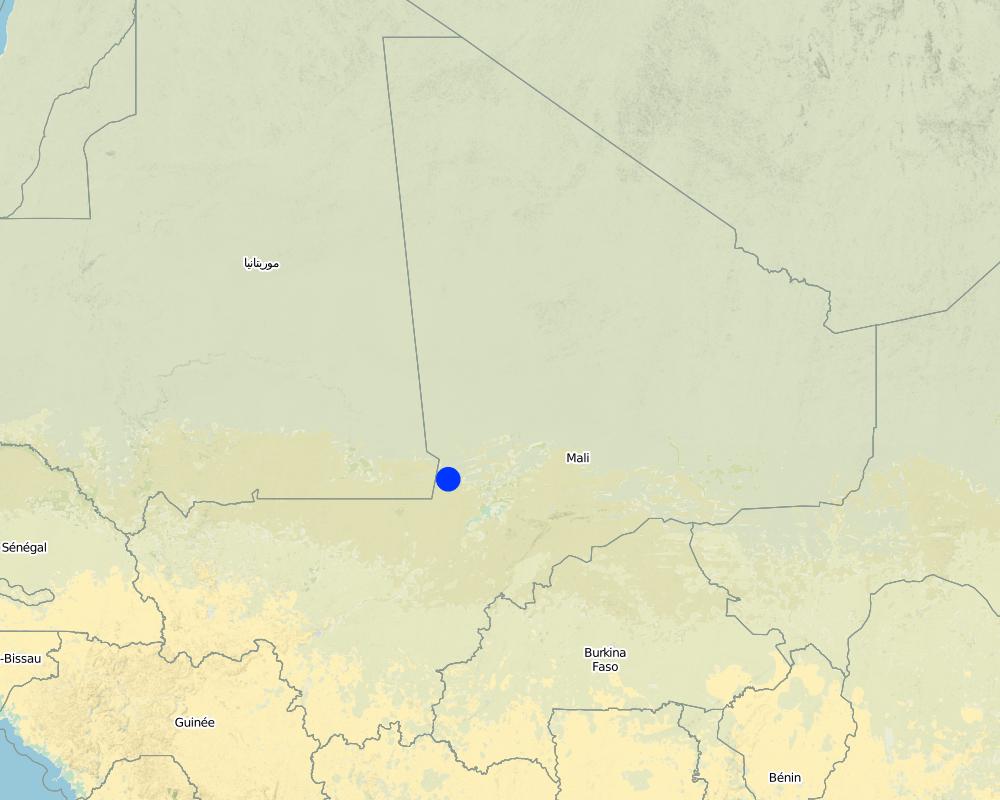Seed Priming and Microfertilization [مالي]
- تاريخ الإنشاء:
- تحديث:
- جامع المعلومات: Unknown User
- المحرر: –
- المُراجع: Fabian Ottiger
technologies_1328 - مالي
عرض الأقسام
توسيع الكل طي الكل1. معلومات عامة
1.2 تفاصيل الاتصال بالأشخاص الرئيسيين لمصدر المعلومات والمؤسسات المشاركة في تقييم وتوثيق التقنية
الشخص (الأشخاص) الرئيسي لمصدر المعلومات
متخصص في الإدارة المستدامة للأراضي:
Aune Jens
+47 67 23 00 00
jens.aune@umb.no
Norwegian University of Life Sciences
Universitetstunet 3, 1430 Ås
النرويج
اسم المشروع الذي سهّل توثيق/تقييم التقنية (إذا كان ذلك على صلة)
Book project: SLM in Practice - Guidelines and Best Practices for Sub-Saharan Africa (SLM in Practice)اسم المؤسسة (المؤسسات) التي سهلت توثيق/تقييم التقنية (إذا كان ذلك على صلة)
Norwegian University of Life Sciences (Norwegian University of Life Sciences) - النرويج1.3 الشروط المتعلقة باستخدام البيانات الموثقة من خلال WOCAT
يوافق جامع المعلومات والشخص (لاشخاص) الرئيسي لمصدر المعلومات على الشروط المتعلقة باستخدام البيانات الموثقة من خلال WOCAT:
نعم
2. وصف تقنيةالإدارة المستدامي للأراضي
2.1 وصف مختصر للتقنية
تعريف التقنية:
Seed priming and microfertilization are two agronomic measures to increase soil fertility and increase crop harvests in semi-arid drylands.
2.2 وصف تفصيلي للتقنية
الوصف:
Seed priming consists of soaking seeds for 8 hours prior to sowing and microfertilization is the application of small amounts of mineral fertilizer to the planting hole.
Purpose of the Technology: Seed priming and microfertilization have been found to be effective in increasing pearl millet and sorghum yields under dryland cropping systems. It is also applicable for cowpeas, groundnuts and sesame. Priming will increase the water use efficiency because the seed can start to germinate immediately after sowing. Results from Mali (Koro and Segou) show that yields can be increased by 50 % if microfertilization is combined with seed priming. Other benefits are reduced labour constraints (thanks to simultaneous application) and risk reduction. Seed priming and microfertilization can be practiced independently from each other; however, the combination reduces the risk of crop failure and shows best results in terms of yield increase. Microfertilization has also been mechanised in Mali.
Establishment / maintenance activities and inputs: Seed priming should be carried out after a rain shower sufficient for sowing (15-20 mm) at the beginning of the rainy season. After soaking, the seeds should be air dried for 1 hour prior to sowing (to reduce the stickiness of the seeds and to reduce risk of burning by fertilizer). Fertilizer (NPK 16-16-16; or DAP) is applied at a micro-dose of 0.3 g per planting station, equivalent to 3-8 kg fertilizer/ha, dependent on plant population density. The air-dried seeds and the fertilizer can be applied simultaneously by first mixing the seeds and the fertilizer and thereafter taking a pinch of the mixture between the thumb and the forefinger.
Natural / human environment: The Mopti region is located in the semi-arid Sahel with an average annual rainfall of 400-800 mm during one 3.5 month rainy season. A participatory rural appraisal (PRA) study undertaken in 1999 identified soil fertility as one of the farmers’ most serious constraints.
2.3 صور التقنية
2.5 البلد/المنطقة/المواقع التي تم تنفيذ التقنية فيها والتي يغطيها هذا التقييم
البلد:
مالي
المنطقة/الولاية/المحافظة:
Mopti Region
مزيد من التفاصيل حول الموقع:
Koro
Map
×2.6 تاريخ التنفيذ
في حالة عدم معرفة السنة بالتحديد، يرجى الإشارة إلى التاريخ التقريبي:
- منذ أقل من 10 سنوات (مؤخرًا)
2.7 إدخال التقنية
حدد كيف تم إدخال التقنية:
- أثناء التجارب/الأبحاث
- من خلال المشاريع/ التدخلات الخارجية
3. تصنيف تقنية الإدارة المستدامي للأراضي
3.1 الغرض الرئيسي ( الأغراض الرئيسية) للتقنية
- تحسين الإنتاج
- خلق أثر اقتصادي مفيد
3.2 نوع (أنواع) استخدام الأراضي الحالية حيث يتم تطبيق التقنية

الأراضي الزراعية
- زراعة سنوية
التعليقات:
Major land use problems (land users’ perception): soil fertility decline, insufficiency or unavailability of arable lands, population growth and its impact on reducing land availability, frequency and length of fallow periods, insufficient flooding of the plains, increasing soil erosion
3.3 مزيد من المعلومات حول استخدام الأراضي
إمدادات المياه للأرض التي يتم تنفيذ التقنية عليها:
- بعلية
3.4 مجموعةالإدارة المستدامة للأراضي التي تنتمي إليها هذه التقنية
- الإدارة المتكاملة لخصوبة التربة
- Seed priming
3.6 التدابير التقنية في مجال إلادارة المستدامة للأراضي

التدابير الزراعية
- A2: المادة العضوية/خصوبة التربة
التعليقات:
Main measures: agronomic measures
3.7 الأنواع الرئيسية من تدهور الأراضي التي تناولتها التقنية

التدهور الكيميائي للتربة
- (Cn): تراجع الخصوبة وانخفاض محتوى المادة العضوية (غير ناتج عن الانجراف)
التعليقات:
Main type of degradation addressed: Cn: fertility decline and reduced organic matter content
Main causes of degradation: soil management (Use of organic and inorganic fertilisers lower than recommended, reduction in fallow period), crop management (annual, perennial, tree/shrub) (removal of crop residues), other human induced causes (specify) (clearing and cultivation of marginal lands), other natural causes (avalanches, volcanic eruptions, mud flows, highly susceptible natural resources, extreme topography, etc.) specify (natural low soil fertility and fragile soils), population pressure
3.8 منع أو حد أو عكس تدهور الأراضي
تحديد هدف التقنية فيما يتعلق بتدهور الأراضي:
- الحد من تدهور الأراضي
4. المواصفات الفنية، وأنشطة التنفيذ، والمدخلات، والتكاليف
4.2 المواصفات الفنية/شروحات الرسم الفني
Technical knowledge required for field staff / advisors: low
Technical knowledge required for land users: low
Main technical functions: increase in nutrient availability (supply, recycling,…)
4.3 معلومات عامة بخصوص حساب المدخلات والتكاليف
عملة أخرى/ عملة وطنية (حدد):
CFA
اذكر متوسط تكلفة أجر العمالة المستأجرة في اليوم الواحد:
2.00
4.6 الصيانة/الأنشطة المتكررة
| النشاط | نوع التدبير | التوقيت/الوتيرة | |
|---|---|---|---|
| 1. | Soak seeds for 8 hours prior to sowing | زراعية | onset of rainy season, late June |
| 2. | Mix seeds and NPK fertilizer (16-16-16) or DAP at a ratio of 1:1 | زراعية | before sowing |
| 3. | Sow seeds and fertilizer simultaneously and cover with soil | None |
التعليقات:
Seed priming and microfertilization are agronomic measures which are carried out repeatedly each cropping season. All activities are listed under maintenance / recurrent activities (below). There is no establishment phase (as defined by WOCAT). Seed priming can be started after sufficient rain for sowing has been received. If the method fails, it can be repeated again. Option: If farmers have the resources to buy higher amount of fertilizer and if the season is promising, they can apply 2 g fertilizer per pocket at first weeding (20 days after sowing). This results in higher yields but also requires an additional operation for the farmer, tripling the labour inputs for fertilizer application. If this practice is adopted, it is not necessary to apply 0.3 g fertilizer at sowing. All activities are carried out by manual labour; microfertilisation has partly been mechanised, using an ox-drawn implement.
4.7 التكاليف والمدخلات اللازمة للصيانة/للأنشطة المتكررة (سنويًا)
| تحديد المدخلات | الوحدة | الكمية | التكاليف لكل وحدة | إجمالي التكاليف لكل مدخل | % من التكاليف التي يتحملها مستخدمو الأراضي | |
|---|---|---|---|---|---|---|
| العمالة | Labour | ha | 1,0 | 1,0 | 1,0 | |
| الأسمدة والمبيدات الحيوية | Fertilizer | ha | 1,0 | 2,0 | 2,0 | |
| إجمالي تكاليف صيانة التقنية | 3,0 | |||||
التعليقات:
Machinery/ tools: weeding tool
Sowing can alternatively be mechanised, which will cause establishment costs (purchase of the sowing machine)
4.8 أهم العوامل المؤثرة على التكاليف
قدم وصفا لأهم العوامل التي تؤثر على التكاليف:
Fertilizers
5. البيئة الطبيعية والبشرية
5.1 المناخ
هطول الأمطار السنوي
- < 250 مم
- 251- 500 ملم
- 501 - 750ملم
- 1,000-751 ملم
- 1,500-1,100 ملم
- 2,000-1,500 ملم
- 3,000-2,001 ملم
- 4,000-3,100 ملم
- > 4000 ملم
المواصفات/التعليقات على هطول الأمطار:
500-750 mm (ranked 1, length of dry period: 8 months) as well as 250-500 mm and 750-1000 mm (ranked 2)
المنطقة المناخية الزراعية
- شبه قاحلة
Thermal climate class: tropics
5.2 طوبوغرافيا
متوسط الانحدارات:
- مسطح (0-2%)
- بسيط (3-5%)
- معتدل (6-10%)
- متدحرج (11-15%)
- تلال (16-30%)
- شديدة الانحدار(31-60%)
- فائقة الانحدار (>60%)
التضاريس:
- هضاب/سهول
- أثلام مرتفعة
- المنحدرات الجبلية
- منحدرات التلال
- منحدرات في السفوح
- قاع الوادي
المنطقة الارتفاعية:
- 100-0 متر فوق سطح البحر
- 500-101 متر فوق سطح البحر
- 1,000-501 متر فوق سطح البحر
- 1,500-1,001 متر فوق سطح البحر
- 2,000-1,501 متر فوق سطح البحر
- 2,500-2,100 متر فوق سطح البحر
- 3,000-2,501 متر فوق سطح البحر
- 4,000-3,001 متر فوق سطح البحر
- > 4000 متر فوق سطح البحر
التعليقات والمواصفات الإضافية بشأن التضاريس:
Altitudinal zone: 1001-500 m a.s.l. (260m)
5.3 التربة
متوسط عمق التربة:
- ضحل جدًا (0-20 سم)
- ضحلة (21-50 سم)
- متوسطة العمق (51-80 سم)
- عميقة (81-120 سم)
- عميقة جدًا (> 120 سم)
المواد العضوية في التربة السطحية:
- منخفضة (<1%)
إذا كان متاحًا، قم بإرفاق وصف كامل للتربة أو تحديد المعلومات المتوفرة، على سبيل المثال نوع التربة، الرقم الهيدروجيني/ درجة حموضة التربة، قدرة التبادل الكاتيوني، النيتروجين، الملوحة وما إلى ذلك.
Soil fertility: Low
5.6 خصائص مستخدمي الأراضي الذين يطبقون التقنية
التوجه السوقي لنظام الإنتاج:
- مختلط (كفاف/ تجاري)
المستوى النسبي للثروة:
- متوسط
- ثري
أفراداً أو مجموعات:
- فرد/أسرة معيشية
مستوى المكننة:
- عمل يدوي
- الجر الحيواني
الجنس:
- نساء
- رجال
اذكر الخصائص الأخرى ذات الصلة لمستخدمي الأراضي:
Land users applying the Technology are mainly common / average land users
5.7 متوسط مساحة الأرض المملوكة أو المستأجرة من قبل مستخدمي الأراضي الذين يطبقون التقنية
- < 0.5 هكتارا
- 0.5 - 1 هكتار
- 1 -2 هكتار
- 2 - 5 هكتار
- 5 - 15 هكتار
- 15 - 50 هكتار
- 50 - 100هكتار
- 500-100 هكتار
- 1,000-500 هكتار
- 10,000-1,000 هكتار
- > 10,000 هكتار
هل يعتبر هذا نطاقًا صغيرًا أو متوسطًا أو واسعا (في إشارة إلى السياق المحلي)؟:
- على نطاق صغير
التعليقات:
2-20 ha
5.8 ملكية الأراضي، وحقوق استخدام الأراضي، وحقوق استخدام المياه
ملكية الارض:
- مجتمعي/قروي
حقوق استخدام الأراضي:
- مجتمعي (منظم)
- فردي
6. الآثار والتصريحات الختامية
6.1 الآثار التي أظهرتها التقنية في الموقع
الآثار الاجتماعية والاقتصادية
الإنتاج
إنتاج المحاصيل
التعليقات/ حدد:
combined effect of seed priming and microfertilisation 50%, seed priming alone 25%
إنتاج الأعلاف
التعليقات/ حدد:
increased production of straw
خطر فشل الإنتاج
التعليقات/ حدد:
Risk minimisation: decreased risk of crop failure; and low financial risk in the case of crop failure; seed priming reduces the risk of fertilizer application
الدخل والتكاليف
النفقات على المدخلات الزراعية
التعليقات/ حدد:
Decreased financial resources needed for purchasing fertilizer, makes the technology feasible for poor small-scale farmers
آثار اجتماعية واقتصادية أخرى
Land productivity
التعليقات/ حدد:
clearance of new land is avoided
Earlier harvest (food security)
الآثار الايكولوجية
التنوع البيولوجي: الغطاء النباتي، الحيوانات
مكافحة الآفات/الأمراض
التعليقات/ حدد:
Increased resistance to Striga (pest)
الحد من مخاطر المناخ والكوارث
آثار الجفاف
التعليقات/ حدد:
Reduced susceptibility to beginning-of-season droughts; less burning effect if drought after sowing
6.3 تعرض التقنية وحساسيتها لتغير المناخ التدريجي والظواهر المتطرفة/الكوارث المرتبطة بالمناخ (كما يراها مستخدمو الأراضي)
تغير مناخ تدريجي
تغير مناخ تدريجي
| الموسم | نوع التغير المناخي/ المتطرف | كيف تتعامل التقنية مع ذلك؟ | |
|---|---|---|---|
| درجة الحرارة السنوية | زيادة | غير معروف |
الظواهر المتطرفة / الكوارث المرتبطة بالمناخ
الكوارث الجوية
| كيف تتعامل التقنية مع ذلك؟ | |
|---|---|
| عاصفة ممطرة محلية | غير معروف |
| عاصفة هوائية محلية | غير معروف |
الكوارث المناخية
| كيف تتعامل التقنية مع ذلك؟ | |
|---|---|
| جفاف | جيدا |
الكوارث الهيدرولوجية
| كيف تتعامل التقنية مع ذلك؟ | |
|---|---|
| فيضان عام (نهر) | غير معروف |
العواقب الأخرى المتعلقة بالمناخ
العواقب الأخرى المتعلقة بالمناخ
| كيف تتعامل التقنية مع ذلك؟ | |
|---|---|
| انخفاض فترة النمو | غير معروف |
6.4 تحليل التكلفة والعائد
كيف تتم مقارنة العوائدمع كلفة الصيانة/التكاليف المتكررة (من وجهة نظر مستخدمي الأراضي)؟
عوائد قصيرة الأجل:
ايجابي جدا
عوائد طويلة الأجل:
ايجابي جدا
التعليقات:
The technology has a benefit-cost ratio of 10 (increased production value is 10 times higher than the costs for additional fertilizer). Compared to the 6 g microfertilisation method (using Coke caps) cost-benefits ratio of 0.3 g treatment is 8-20 times hi
6.5 اعتماد التقنية
من بين جميع الذين تبنوا التقنية، كم عدد الذين فعلوا ذلك بشكل تلقائي، أي دون تلقي أي حوافز مادية/مدفوعات؟:
- 90-50%
التعليقات:
50% of land user families have adopted the Technology without any external material support
Comments on spontaneous adoption: Field officers from NGO’s report that in some villages in the “Dogon area” in the Mopti region more than 50 % of the farmers are using the technologies on their own initiative.
There is a strong trend towards spontaneous adoption of the Technology
Comments on adoption trend: Microfertilization has become a very popular technology in some area in Mali.
6.7 نقاط القوة / المزايا / الفرص التي توفرها التقنية
| نقاط القوة/ المزايا/ الفرص من وجهة نظر جامع المعلومات أو غيره من الاشخاص الرئيسيين لمصدر المعلومات |
|---|
| Decreased financial resources needed for purchasing fertilizer, makes the technology feasible for poor small-scale farmers |
| No additional labour inputs (the technology does not significantly increase sowing time due to simultaneous application of seeds and fertilizer) |
| Adaptability to different land use systems: micro-fertilization can also be mechanised |
6.8 نقاط ضعف / مساوىء / مخاطر التقنية وسبل التغلب عليها
| نقاط الضعف/ المساوىء/ المخاطر من وجهة نظر جامع المعلومات أو غيره من الاشخاص الرئيسيين لمصدر المعلومات | كيف يمكن التغلب عليها؟ |
|---|---|
| Dependence partly on availability of mineral fertilizer | the technology should be combined with complementary methods for maintenance of soil fertility, such as increased recycling of crop residues as mulch and manure application |
7. المراجع والروابط
7.2 المراجع للمنشورات المتاحة
العنوان، المؤلف، السنة، النظام القياسي الدولي لترقيم الكتب ISBN:
Aune JB, Doumbia M, Berthe A (2007): Microfertilizing sorghum and pearl millet in Mali - Agronomic, economic and social feasibility in Outlook on AGRICULTURE Vol 36, No 3, 2007, pp 199–203;
العنوان، المؤلف، السنة، النظام القياسي الدولي لترقيم الكتب ISBN:
Aune JB, Doumbia M, Berthe A (2005): Integrated Plant Nutrient Management Report 1998-2004; Drylands Coordination Group Report 36, Norway;
العنوان، المؤلف، السنة، النظام القياسي الدولي لترقيم الكتب ISBN:
Aune JB, Bationo A (2008): Agricultural intensification in the Sahel. Agricultural Systems 98: 119-125
العنوان، المؤلف، السنة، النظام القياسي الدولي لترقيم الكتب ISBN:
Habima, D. 2008. Drylands ecofarming: An analysis of ecological farming prototypes in two Sahelian zones: Koro and Bankass. M.Sc Thesis, UMN, Ås, Norway
الروابط والوحدات المواضيعية
توسيع الكل طي الكلالروابط
لا يوجد روابط
الوحدات المواضيعية
لا يوجد وحدات مواضيعية







